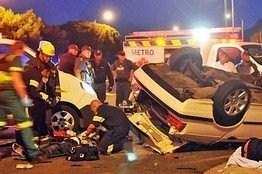A Closer Look at South Africa’s Dangerous Roads

Millions headed out of South African cities to beaches, mountains or back to family villages for the holidays. Many didn’t arrive or return alive.
On Thursday, South Africa’s transport minister said that 1,465 people lost their lives over a five-week period, from Dec. 1 to Jan. 8. In a speech, the minister, Dikobe Ben Martins, blamed the accidents on drunken-driving, speeding, shabby vehicles and passengers who don’t wear seat belts. He said 40% of the fatalities involved pedestrians, “most of whom walk on the road while drunk.”
In some previous holiday seasons, 1,704 died in a similar period in 2010-11, and there were 1,582 fatalities in the 2009-10 period. Annually, Mr. Martins said Thursday, the carnage costs South Africa’s economy 306 billion rand ($35.04 billion), or roughly 10% of its gross domestic product.
So after South Africa’s great holiday migration comes to end, the soul-searching typically begins: Why are roads of the continent’s most advanced economy so deadly?
South Africa averages 33.2 road fatalities per 100,000 people, far more dangerous than the U.S. at 13.9 though slightly safer than war-torn Afghanistan at 39, according to 2009 estimates from the World Health Organization. During holiday season, South Africa’s figure spikes higher, to 40 to 42 a day, according to Ashref Ismail, a spokesman for the Road Traffic Management Corp., an agency of the transport ministry.
Among its emerging-market peers, South Africa fares poorly. Brazil is estimated to have 18.3 fatalities per 100,000 people, Russia 25.2, India 16.8 and China 16.5. In Africa, though, several others rank higher, including Eritrea, which topped the WHO list with 48.4 road fatalities per 100,000 people.
While South African roads can be dangerous—poorly lit and not well-marked—a bigger peril comes from other drivers. Some people change lanes with abandon; blinkers often appear optional; overcrowded jalopies mix with big-engine Land Rovers and BMWs barreling toward their destinations.
The result is a treacherous mix of slow and fast, poor and rich that mirrors South Africa itself, a country of vast disparities and historical animosities that sometimes spill into the streets.
“South African drivers are generally very aggressive, lack consideration and are extremely impatient,” says Mr. Ismail. Add bad drivers and balky vehicles, he says, and “it’s a recipe for disaster.”


